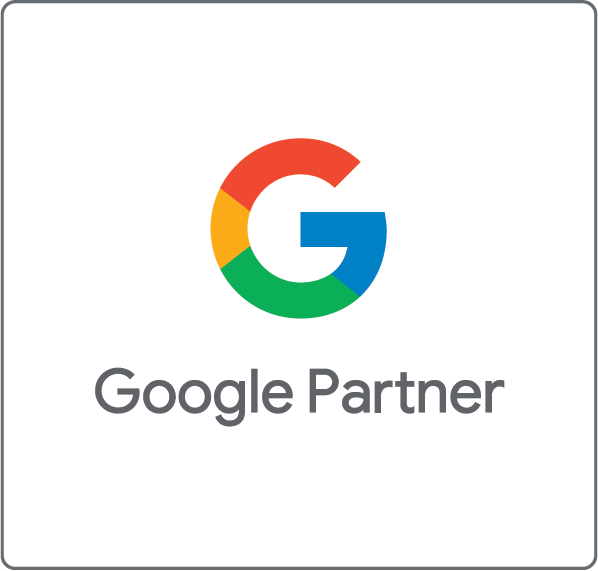What is Legal Marketing?
Taken solely at face value, legal marketing is a way to make the public aware of your firm, who you are and what you offer. Like any other form of marketing, it means targeting the perfect audience – e.g. potential clients – and creating content that speaks to them, highlights what you can do for them and helps them better understand your purpose and values.
But that’s just the textbook definition. What legal marketing allows you to do, which is vitally important in capturing and keeping public attention, is tell the story of who you are. Legal marketing is the vehicle through which you educate potential clients; not just sell to them. It lets you present yourself as the pathway to potential clients’ goals, showing them the benefits, you offer and empowering them to choose you over others.
Through legal marketing, you don’t just create brand awareness. You don’t just create a sales pitch. You build trust, you enhance your own reputation and you drive client retention and referrals moving forward.
And you do all this by meeting potential clients where they are: online. Consumer behavior has undergone a seismic shift in recent years. It’s not enough to have an online component to your marketing efforts – you need to be proactive in establishing your brand in the digital world where your audience gets their information, seeks out answers and educates itself.
Legal marketing allows you to remain relevant in your efforts to attract and keep clients online, while building partnerships and networking with other professionals to build referrals.
What Makes Legal Marketing Challenging for So Many Law Firms?
Being a good attorney does not necessarily make a great marketer. And that’s OK – your legal expertise is what sets you apart in your field. It’s the reason your firm exists, and the reason clients seek your firm out. Most law firms simply don’t have the training to execute on the kind of marketing that brings those clients in the door.
But it’s an important facet of running a successful firm. Clients today can get legal expertise anywhere. What they’re seeing from you is a strong relationship and substantive results, built on a foundation of strong ethics. That sort of trust is where legal marketing excels, particularly in the modern era of social media and online promotion.
So what’s holding your firm back from creating these connections?
You’re Tied to Tradition: Whether from reluctance to embrace new technologies or through adherence to legacy marketing, you may simply be putting your efforts toward outdated avenues of marketing. Conventional marketing has served legal firms well for a long time, but the landscape has changed. Savvy firms change with it.
You Don’t Have the Resources: Your firm may not have its own in-house marketing firm, leaving this crucial task to employees who can soon find themselves overwhelmed. Or you may simply not have the budget. Especially for smaller firms, the financial hurdle of creating quality digital marketing may simply be too high.
You Lack a Cohesive Strategy: Some firms struggle to grasp the importance of a robust online marketing strategy, while others struggle to execute on their ideas. Some may be hesitant to engage in the kind of media and content creation that attracts clients and drives engagement.
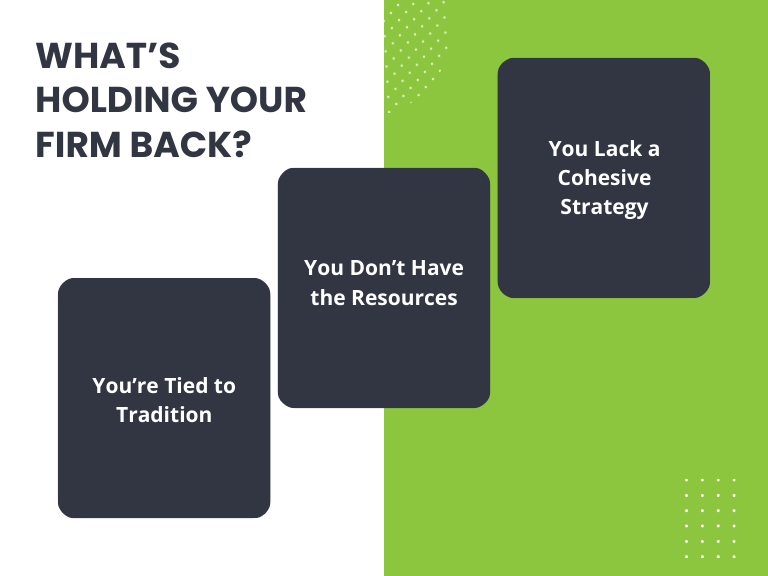
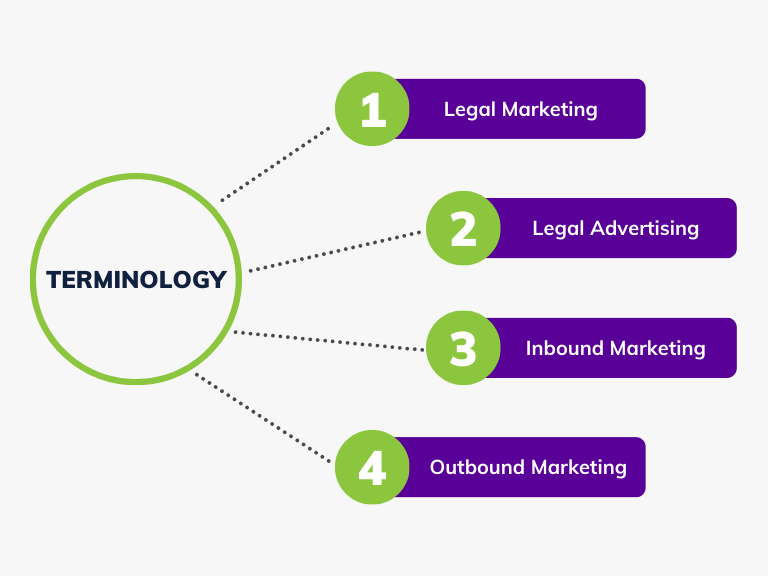
Inbound, Outbound, Marketing and Advertising: A Brief Primer on Terminology
Before we delve further into the nuts and bolts of legal marketing and why it’s so effective, it may be helpful to define some of the language marketers use to describe what they do and what they don’t do.
Legal Marketing: Essentially a blanket term for those approaches and strategies that law firms can use in positioning themselves within their market as a voice of authority and a trusted partner for their clients. This differs tremendously from firm to firm.
Legal Advertising: Not quite as comprehensive as legal marketing, but still important, legal advertising is a means for conveying a firm’s value proposition. As a paid promotion on billboards, broadcast, print or online ads, it is simply paid promotion for a firm.
Inbound Marketing: These are the strategies used to draw potential clients toward a law firm organically, comprising everything from blog posts and videos to Webinars and e-mail campaigns. This is typically done through educating and empowering an audience with knowledge of the legal world that not only helps them address their legal problems but also establishes the law firm as a thought leader. A ” thought leader” refers to a person or groups known for their exceptional knowledge and wisdom in their given area of law. They are the trusted attorneys that know their area of law so well that they are revered by the public and peer attorneys for their expertise.
Imagine inbound marketing as simply presenting your firm’s legal expertise to the world, providing valuable information that clients can use to make their own informed decisions when choosing a law firm.
Outbound Marketing: If inbound marketing is for pulling in potential clients attention by helping and educating them, outbound marketing is for pushing your services on them, presenting them to potential clients directly through avenues such as television commercials, radios ads, magazines, direct mail, trade shows, and broad advertising. This approach markets in a way that’s not dissimilar to traditional advertising, promoting specific services in the hopes that message may resonate with clients who need them.
All of these various strategies represent key components in a law firm’s overall strategy, marrying the reputation-building effectiveness of inbound marketing with the highly visible promotion of outbound marketing.
The New to Approach Legal Marketing
Think of how you used to learn about what law firms existed in your area. There would be ads in the local paper, there would be regular spots on radio and television, and of course there would be billboards. Most folks would find their law firm in the Yellow Pages, or through word of mouth.
Those methods worked well when those were the only avenues for having your message heard. But today, they are a very small part of the overall picture. Today’s law firm needs to capture the attention of a tech-savvy public, one that interacts with their world through the screen, utilizing Google and social media, information-heavy websites, video and e-books to gain their trust.
Today, the largest emphasis of your overall legal marketing strategy needs to be digital, utilizing as many platforms as possible and following best search engine optimization best practices to reach people and developing a sound content strategy to keep them engaged. Does this mean simply handing out information and expertise for free? Yes, but this is how thought leadership and domination of the market are built. It’s the best way to create long-term success for lawyers and law firms.
This guide, for example, contains extensive information on legal marketing – how it works, what makes it effective, and how to properly utilize it. And you didn’t pay a dime for it. Educating you and empowering you as the client is job one.
And it’s important that you be well-educated on legal marketing, because it is a sector that has seen a massive revolution over the last few years. Some highlight of these changes include:
The Revolution Will Not Be Televised: Yellow pages and print advertising have been paying reduced dividends for years as consumers began getting the majority of their information online. But even television advertising, long a staple of legal marketing, has proven less effective as consumers opt for different forms of entertainment. Putting your message out online, using a website that ranks well with search engines and through platforms like YouTube and social media, has become paramount.
It’s Not About You: There’s a great saying in legal marketing that both rings true and is fun to say: your ego is not your amigo. If you look at traditional advertising and marketing, the message was always the same: your firm is the greatest, your attorneys are the most skilled and your track record shows that all you do is win. And although that may be true, the new approach to legal marketing is less about you and more about your clients. You want to show them you understand their challenges and you listen with empathy and understanding. You are not the lawyer with the cape and accolades, but the compassionate advocate that is there to help.
Cutting Through the Static: A significant shift in legal marketing is the heightened necessity to stand out amidst the overwhelming flood of promotional efforts from competing law firms making the landscape more cluttered and saturated. You already know that. What this new approach to legal marketing helps you do is stand out from that crowd, with content that delivers value and a message that resonates with clients.
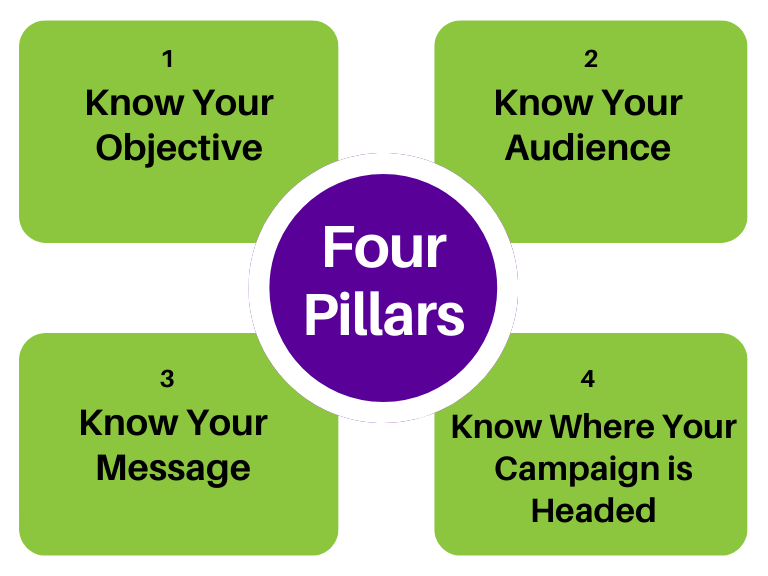
The Four Pillars of Legal Marketing Success
Behind every successful legal marketing campaign is a comprehensive strategy informed by an in-depth knowledge of your goals and objectives, as well as your audience and your message. The formula that defines this strategy rests on four pillars, each of which must be sturdy enough to elevate your marketing to where it needs to go.
Know Your Objective
While “paralysis by analysis” or not taking action is a danger in any undertaking as robust as a legal marketing campaign, it is still crucial to establish your goals and objectives at the outset. Does your firm want to establish itself as subject matter expert in a specific field of the law? Are you aiming to attract more clients? Are you simply looking to increase the visibility of your brand? That initial goal informs every aspect of the roadmap, tactics and benchmarks that follow. The more work you put in at the beginning, the easier it will be later to track progress, ensure internal buy-in, and continue to channel resources effectively throughout the campaign. Failure to define goals and objectives early on risks leaving the entire campaign unfocused, difficult to manage, and ultimately unsuccessful.
Know Your Audience
Building trust in the beginning of a legal marketing campaign is of the utmost importance, and in order to do that you must fully research, analyze and understand your intended audience. Just as important as understanding your goals, understanding your intended audience will help you fine-tune your message, ensuring that you are reaching the right groups and communicating with them effectively. This includes everything from creating communication strategies tailored specifically to your audience, determining the best avenues for reaching them, and determining the legal areas on which to focus in your messaging and content. Failure to define your audience can leave your legal marketing unable to create those vital connections with potential clients.
Know Your Message
The science behind this pillar has evolved rapidly in the last few years, as research has defined the psychological rules that dictate behavior online, as well as the practical rules that help elevate content in the age of search engine optimization. Truly authoritative content performs better on both levels, engendering a sense of trust among an audience and performing better in the way sites like Google index it in their database. Throughout a successful legal marketing campaign, the emphasis must be on putting out content that is valuable, credible, reliable, and consistent. From a psychological perspective, it must resonate with the audience on a level deeper than simply informational, aspiring to emotional and cognitive connection. From a SEO perspective, it must be unique, well written, and presented in different formats ranging from written webpage articles, to blog posts, videos, and Podcast audio.
Know Where Your Campaign is Headed
The final pillar of a strong legal marketing campaign is one which may require further elaboration than a simple paragraph can provide. Suffice it to say, it is of vital performance that you establish a strong online strategy at the outset of the campaign, determining your ideal distribution and promotion plan across search engines, social media and digital advertising platforms. As the science behind online marketing has evolved, this final pillar has gained greater performance, even as the entire online ecosystem continues its evolution.
The State of Online Legal Marketing
Creating a strategy behind distributing your legal marketing campaign requires a thorough understanding of the online landscape, which can be difficult as platforms rise and fall in popularity, changes in algorithms impact what content is shown where, and end users shift in how they consume information.
As of this writing, the biggest part of any legal marketing strategy is a strong presence on search engines. And as of this writing, the leading search engine in the world, the one that sets the tone for online marketing, is Google. A high Google ranking is vital for connecting you with potential clients, building their loyalty and trust, ensuring long-term visibility and success. This ranking is built organically on the strength of a well-optimized website, meaning that your Google ranking is separate from any paid advertising. It’s a more cost-effective approach, albeit one that requires a little extra work. But the dividends it pays are tremendous.
Another crucial part of your online presence is establishing your law firm’s profile across the many social media platforms in existence. These platforms have evolved to be more than just a way for people to connect with one another, but for them to connect directly with the brands that interest them. These channels are where they get their news, where they learn about the latest cultural trends, and where they build their communities.
Each of these platforms represent a unique channel for your message, with their own intended audience, their own types of content and their own purpose. The great forum of the modern age, Facebook, still represents an ideal way to impart a mass message, but each offers its own niche. X, for example, is ideal for quick news updates and rapid communication. Instagram, Pinterest and Tik Tok offer avenues for connecting on more aspirational or emotional level, while professional sites like LinkedIn help connect your firm with other professionals and thought leaders.
While social media offers a dynamic avenue for reaching a particular audience or sharing a certain message, they may be ineffective for certain firms. Depending on your legal specialty, it may be more beneficial to focus your efforts primarily on search engines.
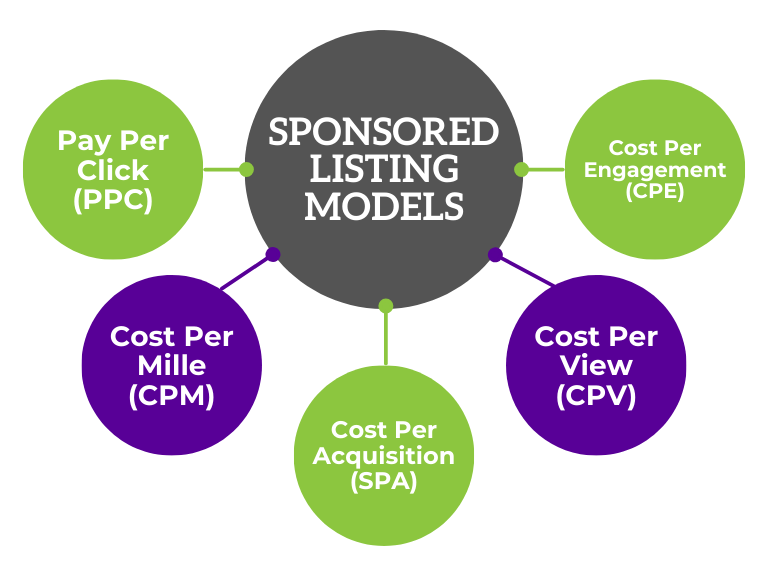
Beyond Legal Marketing: Advertising
Just as billboard ads have helped law firms reach new customers and establish their reputations for years, digital advertising serves as an effective tool in a marketing campaign. One distinct advantage offered by online advertising is the ability to target your ad, ensuring that it reaches the exact audience you had in mind for it. Whereas a roadside billboard broadcasts wide to whichever motorists happen to be passing by, online advertising can lock on to a specific demographic, age group or geographic region.
One avenue for these ads is paid placement on search engines. The major players in this space, currently Google and Bing, offer placement above their own organic search results for advertising. This means that your firm can bid on specific keywords. For example, you may choose “personal injury lawyer,” “criminal defense attorney,” or “divorce attorney,” and combine these with terms that specify your geographical region. When a user searches for those terms, they will see your sponsored result at the top of the organic results for those terms.
This can offer a great opportunity to those firms that haven’t yet established their presence on search engines, giving an immediate exposure to the search engines. The caveat here being that it will cost you for each click to your website. While raising your profile organically by optimizing your site and establishing your credibility merely costs time and resources, search engines charge for these sponsored listings using a variety of models:
• Pay Per Click (PPC): This pricing model charges for each user that clicks on the promoted link, with the charge being determined by several factors such as competition for certain keywords.
• Cost Per Mille (CPM): Generally used for campaigns that aim to boost brand visibility, this pricing structure bills for every 1,000 displays of the ad.
• Cost Per Acquisition (SPA): This goes beyond the price per click by charging based on actions that users take after clicking through to your site.
• Cost Per View (CPV): Generally reserved for video content, this pricing structure allows you to promote individual piece of content, paying for every user that views it.
• Cost Per Engagement (CPE): This pricing structure allows for greater flexibility in campaigns where a click-through isn’t the necessary goal, billing based on the user’s interaction with the ad.
In addition to these structures, some platforms offer a flat rate for advertising, allowing for more predictable costs. There are also options for programmatic buying, in which ad space is auctioned off in real time. There can be a tremendous variation in costs based on the particular model and platform, so it is vital to understand the specifics on each in order to maximize your return on investment.
Optimizing Your Website and Your Content
More effective than any advertising or social media engagement strategy, is your website, which should be the driving force of new clients and growth for your law firm. As essentially the front door of your office, it needs to present itself as polished, professional and easily accessible. On a strictly utilitarian level, it should be easy to navigate across platforms, whether accessed on a desktop computer or on a smartphone (as nearly 80% of all web traffic is served to mobile users). It should also serve a robust library of content, presented in a way that is easily understood, engaging, authoritative and conducive to smart decision-making.
Your website will be the biggest driver of your content strategy, meaning it will store the content you create and distribute across the various channels of your legal marketing. As outlined previously, this content should both educate and engage your audience, providing them with actionable and reliable information, so they will not only consume but share that content with others. Whether a webpage article, a blog post, video content, whitepapers or infographics, it all serves the overall strategy.
And that strategy works hand-in-glove with your search engine optimization efforts.
Say, for example, your firm specializes in representing victims of car accidents. One possible way to reach an audience would be to create content that targets them, but also offers information they need in that moment. One avenue for that, offered here merely as an example, would be a comprehensive guide to “What Comes Next after a Car Accident.”
The concept alone is an ideal strategy for reaching this audience – timely, authoritative, empowering and valuable. Crafting that content needs to be deliberate, drawing on the expertise of not only legal minds, but also skilled designers, videographers and search engine optimization specialists to ensure its value not only to the audience, but to the search engines that will index this valuable information.
If done correctly, in a manner that is clearly organized and researched, incorporates several different media elements from video to graphics, and offers the audience actionable insight they can’t find anywhere else, this singular piece of content can have multiple benefits. It not only serves as a valuable tool for promotion, it helps create rapport with an audience, boosts your website, elevates your standing in the community and greatly increases your visibility on search engines.
We’ve seen clients adopt a similar approach to the one outlined above and reap benefits that extend far beyond their initial legal marketing efforts. This strategy leads to a “multiplier effect,” where the content is not only cited by journalists at major news organizations but also referenced on Wikipedia, shared across the community, and recognized as a significant reference tool. The advantages are wide-ranging, and it all begins with harnessing the reciprocal power of astute content marketing and search engine optimization.
Legal Search Engine Marketing: Play it Again, SEM
Another vital component to legal marketing is legal search engine marketing (SEM), which involves the use of organic and paid strategies for increasing your firm’s profile on search engines while promoting your services to the ideal audience. A well-designed SEM strategy relies on three different components: organic search optimization, local search engine optimization and pay-per-click.
Organic Search Engine Optimization
The person tasked with your campaign’s finances will love this component, as it is the only one achieved without paid advertising. Essentially, this involves optimizing your website to be more visible for search engines, and creating the kind of quality content that attracts visitors, thus boosting ranking. Rather than a one-time investment, proper organic SEO is a long-term set of revolving expenses, for things like research, content creation and strategizing.
In some cases, this starts with a complete overhaul of your website’s content to gain recognition from Google as a publisher of authoritative content. It continues with a consistent effort to create, post and promote high-quality, well-researched content. Since 90% of the volume of searches on Google come from the organic results, it is imperative to use invest the majority of your budget in this type of marketing, and it is important to understand that this type of marketing is a long marathon and not a sprint to achieve success.
Let’s put ourselves in the shoes of your target audience. Imagine a person who has just been involved in a car accident – someone who doesn’t know any lawyers personally, but knows that they need legal help. When they type “personal injury lawyer” or “criminal defense lawyer “into Google, they’ll not only be matched up with attorneys that serve their local area, they’ll be presented those attorneys in the order Google feels would be the most relevant.
Organic search engine optimization is how you place your law firm in those first few results – ideally at the top. Adding to that visibility, if our hypothetical person finds authoritative content on your site, content that proves your experience and expertise in that field and speaks to their specific needs, they will be far more likely to reach out for a consultation. And all it took was your firm following a strategy that builds value as your organic reach grows.
Local Search Engine Optimization
Obviously search engine optimization is important, but it doesn’t do much good for your law firm to court clients in cities and towns that are too far for you to travel to. This is where local search engine optimization comes into play, tailoring your online presence to nearby customers through local search engine optimization.
In the previous example, we mentioned that Google will match our hypothetical accident victim up with a law firm in their local area, but that doesn’t happen on its own. Targeting that local search is a matter of ensuring that your firm’s business information is listed in as many third-party local directories as possible, plus tailoring your site’s content and targeted keywords toward your targeted area.
Organic SEO and local SEO work in harmony to support one another, with your organic SEO efforts helping to create a larger digital footprint for your law firm, and local SEO ensuring your firm is ranked ahead of the competition in your area. These two concepts work so closely together that most legal marketing companies will focus on both in tandem, with the associated costs being set based on competition within the area and the amount of work involved.
Pay-Per-Click
Just as organic and local SEO work together symbiotically, the whole of your optimization efforts must be paired with a strong strategy for pay-per-click (PPC) advertising. Using this model, your firm essentially “buys” traffic, paying Google or Bing for advertising with each visitor who clicks through an ad to your site.
There are several reasons your firm might want to pay for advertising on the major search engines, not least of which being that PPC can account for as much as 10% of total search traffic on Google. First, it can be a great way to build search engine visibility at the outset of an organic SEO campaign. In addition, seasonal PPC buys can help boost traffic to your site during specific times of year when interest in certain services may be highest.
One example of this seasonal buy, one that highlights the effectiveness of PPC in general, would be someone who is overserved at a company holiday party and finds themselves arrested for DUI. When they turn to Google and search for information on the consequences of a DUI, they’re not going to be in a mindset for a deep-dive search. They’re going to click one of the first links they see, and if your firm is running a PPC campaign, you’ll be right at the top of their search results.
Google Local Service Ads
Google Local Services Ads is a platform where local businesses pay for leads rather than clicks, appearing towards the top of Google searches for local services. Benefits include greater local visibility and the trust-enhancing Google Guarantee. Drawbacks involve appearing only for certain services and locations, and paying for leads that may not always convert. In the legal field, this can be beneficial for some practice areas but less so for others, as lead quality may not always meet expectations.
Beyond SEM
While search engine marketing is a vital part of legal marketing, it represents just one aspect of a multi-tiered approach that truly helps your firm achieve its goal of gaining clients and increasing visibility.
Social Media Marketing
Social media marketing is all about empowering your potential clients with knowledge and confidence. By creating compelling content across a variety of channels, from Facebook and Instagram to TikTok and YouTube, you essentially create your own advertising by talking directly to your clients. Essentially, they will consume your content because they find it interesting, educational or just entertaining. And when they require legal representation, your firm will be the first one that comes to mind.
Influencer Marketing
Influencers are those who leverage their social media following into a livelihood, forging partnerships with organizations that align with their brand and serving as their own promotional venue. Just as they use their own credibility to guide their audience toward purchasing decisions, they offer that credibility to other businesses that hope to reach that same audience. This is obviously contingent on finding an influencer whose brand dovetails with your own. For example, many real estate agents promote themselves by building their brand as influencers, making them natural partners for real estate law firms. Environmental law firms might find an influencer who has built a community around green causes. Immigration law firms might find working with influencers inside the communities they serve a great way to introduce their services.
Broadcast Advertising
Despite what we may have implied in this guide’s intro, traditional broadcast media is still a strong part of any legal marketing strategy. Your audience mostly lives online, but they still consume broadcast media – even if only unintentionally. Services like YouTube TV and Hulu still offer traditional networks, giving your advertising message a platform to reach cord cutters. And walk into any place of business and you’ll no doubt hear the local radio station, with all the ads that go with it. As an added bonus, costs associated with traditional media have been declining as digital advertising has gained importance, making this an affordable option even for prime time slots and heavy rotation.
Podcasting
Nothing shows the transience of online audiences like the rise of the podcast over the last decade. Whereas blogs once reigned supreme as a way to advance a conversation or present a point of view, podcasts are now the de facto way to be seen (or at least heard). If your firm is looking for a way to not only present itself as subject matter experts, but open up a conversation with potential clients, a well-produced podcast can yield amazing results. There are, naturally, costs associated with recording, production, promotion, equipment and guest fees. But the dividends can be tremendous.
Email Marketing
While your search engine and social media marketing efforts are aimed squarely at courting clients where they get their news and entertainment, email marketing gets them right where they live: their inbox. One of the strongest forms of marketing from a pure ROI standpoint, this method gives you a direct rout to advertise services, engage with potential clients and drive engagement. Associated costs will vary based on the desired platform, size of the mailing list and amount of content created for each email campaign.
Public Relations
From managing events and working with media to creating messaging on the fly to address a crisis, a good PR firm plays an important role in maintaining your law firm’s reputation in the community and its relationship with the general public. Associated costs will vary based on your law firm’s needs and local competition, but a quality firm can do far more than simply write press releases. Their close ties to local media can help boost your firm’s credibility by offering up your attorneys as subject matter experts on local TV news shows and across local media.
Print Marketing
Even in a digital world, there’s something to be said for giving your clients something they can hold in their hand. From flyers and brochures to ad buys in local papers and magazines, print marketing remains a viable way to reach your audience. And while the cost of creating printed collateral can vary based on circulation, placement or quality of graphic design, the right ad in the right place can play a tremendous role in capturing attention.
Direct Mail Marketing
Yes, so-called “junk mail” gets a bad rep, but there’s no denying the ability of direct mail marketing to target specific demographics within the communities you serve. Whether a flyer, letter or a postcard, your marketing material stands out among the bills and correspondence in your potential client’s mailbox, delivering powerful top-of-mind recognition when they need you most.
YouTube Marketing
As the largest video-sharing website in the world, YouTube attracts millions of viewers and content creators, all uploading and viewing videos across every platform and device imaginable. More to our purposes, as the second-most-visited website in the world, it represents a massive opportunity for giving your content a global audience.
As with most other forms of online marketing, there are two ways to engage with your audience on YouTube. Organic marketing through YouTube requires more input in terms of time and effort, but can be an excellent way to build a long-term relationship with prospective clients. Paid marketing, on the other hand, allows for greater tempo, boosting your signal across the platform for immediate results.
Organic YouTube Marketing
Organically, YouTube makes it possible to creating engaging content that speaks to your specialized skills and experience, while engaging with your community and boosting your SEO through relevant key words and tags. As YouTube doesn’t charge to upload videos, costs involved largely derive from the amount of time it takes to create content consistently, which is necessary for long-term growth. There will also be costs for equipment and personnel to aid in creating content that resonates.
Paid YouTube Marketing
By paying for ads, your content can be displayed before or during videos, or as ad banners, with a dashboard that that lets you zero in on certain demographics while exercising complete control over your budget. The advantages are considerable, with analytics that let you measure your return on investment in real time, and the capability to get your message out much faster and at greater scale. The costs involved are usually determined on a cost-per-view (CPV) or cost-per-click (CPC) basis, will vary based on your goals and intended reach.
Getting Down to Brass Tacks: Return on Investment
At the end of the day, your biggest concern as a law firm is pursuing a marketing strategy that delivers the most bang for the buck. Let’s start with the one aspect that needs to be the centerpiece of your marketing efforts: your website. As the front door of your firm online, it should reflect your polished professionalism through compelling imagery, content that engages and informs, and an interface that exudes simplicity.
With 60% of all traffic online coming from search engines, it should be optimized for easy searchability, with a format that’s easy to find through desktop or mobile searches. With somewhere in the range of 90% of Google traffic coming from users clicking on non-paid search results, it’s easy to see the immediate benefits of a website designed from the ground up to work with search engines.
As such, it’s not uncommon for firms to put all their chips in the middle when it comes to search engine optimization, earmarking between 80-100% of their budget just for SEO. That said, there is still some wisdom in budgeting for pay-per-click ads, which make up 15-20% of internet traffic, as well as social media marketing, which accounts for 5-15% of all traffic.
But regardless of where you choose to put your budget, ensuring a steady return on investment from any of these sources relies on one immutable truth of online marketing: Content is king. Regardless of the platform, or whether that content be in the form of blog posts, social media, vlogs, eBooks or infographics, your content is how your audience finds you. It needs to be compelling, relevant to your audience and your specialty, and offer unique insights and solutions that effectively inform clients.
If you want to see the greatest return on your investment in the digital age, put all of your chips on content, then let it ride.
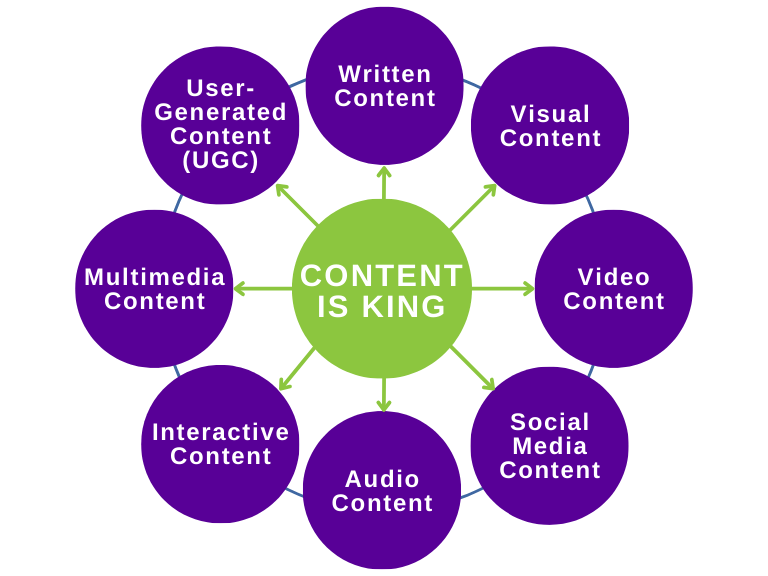
Content is King
When referring to online marketing, or indeed the online experience in general, the word “content” can carry countless meanings. Essentially, it’s a blanket term for everything you see, hear, and consume online. Some examples of content include:
Written Content: Covering everything from blog posts and standalone articles to the copy on your website, written content is a key component of legal marketing. The reason being, the written word is still the best way for Google to index and rank your site, which boosts traffic. But it’s still a great way to engage with your human audience as well, giving them valuable information in a format that is easily shared and bookmarked to multiply its reach.
Visual Content: By this we refer to any kind of imagery you produce – photos, graphics, illustrations, infographics, etc. Right now, this content is more helpful in engaging with your audience, creating a stronger emotional response and keeping their attention while helping them better understand complex information. As visual search through artificial intelligence becomes more refined, visual content will play an even bigger role in search visibility in the future.
Video Content: Ever since Google purchased YouTube, the search engine has made video content – posted on YouTube or elsewhere – a much bigger part of its indexing algorithm. With proper metadata from keywords to titles, video content can give a tremendous boost to your visibility. But beyond the SEO aspects that make video content attractive, it also serves a massive (and growing) audience that favors watching content more than reading content.
Social Media Content: These are the Tweets, Instagram Reels, TikToks and Facebook posts that you create to help build your audience across the various social media platforms. If produced consistently and with an authentic voice, this content can foster a tremendous sense of community among followers, helping your firm establish itself as a thought leader, engender loyalty and build your reputation.
Audio Content: As the most notable type of audio content, podcasts offer a tremendous avenue for establishing your firm as a thought leader and engaging with an audience of potential clients. The long-form nature of podcasts make them an ideal vehicle for breaking down complex ideas in a way that is easy to understand, while the medium itself allows your audience to engage while multitasking. And with numerous platforms for distribution, the potential audience is enormous.
Interactive Content: This type of content covers anything placed on your website that your audience can truly interact with. By encouraging them to click through to discover information and content, you not only present information in a way that is easily understood and retained, you encourage users to spend more time on your site. This is a valuable metric for search engines, which base rankings partially on the length of an average visit as this is a good indicator of quality content. Plus, interactive experiences have been shown to lead to higher conversion rates for clients.
Multimedia Content: Especially in the context of legal marketing, multimedia content is a powerful tool for engaging with an audience. The legal field can be intimidatingly complex to outsiders, but with content from e-books to explainer videos you have the ability to break down confusing concepts into easy-to-understand (and sharable) content. In addition, multimedia content raises average length of visit, driving SEO, and creates stronger connections with your audience.
User-Generated Content (UGC): The entire purpose of creating content is to build a connection with your audience and to turn potential clients into supporters. User-Generated Content is how you know it’s working. Encompassing user reviews, client testimonials, public comments and Q&As, user-generated content is a Swiss army knife of content. It shows the value you offer to clients, helps cement your online community, and boosts SEO by offering a steady stream of relevant content.
Like it or Not, You Are The Media Now
Before the Internet democratized how information is spread, the ability to reach people was held exclusively by large media companies – newspapers, television and radio stations, etc. Back then, if a law firm wanted to reach potential clients, they were the only game in town.
Now the masses are the media, and that includes your law firm. Rather than relying on traditional media outlets, you have all the tools you need to spread your message far and wide, engaging with your audience on your terms. To properly utilize those tools, you essentially need to view yourself as an independent media entity.
And like any media entity, your every move should be predicated on what your audience wants, and more importantly how they communicate. Think back to when you first started studying law, and how impenetrable the terminology seemed. The trap many law firms fall into is continuing to speak “legalese” in communicating with their audience, ultimately talking over their heads.
But it’s not just the jargon – in attempting to speak with their audience, too many law firms speak to their audience. Your marketing shouldn’t be a matter of simply rattling off your firm’s many qualifications, successes and awards. It should be about forging connections with your audience, laying the groundwork for them to become clients. It requires empathy toward their legal woes, understanding of the anxiety they may be going through, and assistance that is given without expectation that it will result in a new client.
That last part can be the aspect of legal marketing that law firms are most resistant to – expending valuable time and resources on simply providing resources and information to the general public free of charge. But legal marketing is not a sprint, it’s a marathon. The assistance you give today may help countless people without putting a dime in your pocket. But it pays dividends. In the short term, a handful of those people who benefit from your expertise will have a newfound sense of faith in your firm and will seek you out when they need representation. In the long term, your firm will have seen its reputation and visibility soar as the content you create sets you apart.
The Content You Create Matters
Whether in written or video format, through interactive elements or podcasts, the content you create matters. But it always helps to look at which types of content will have the most impact, how that content will affect your audience, and what makes that content so effective.
Let’s start with impact. As you may have surmised from reading this far, the online ecosphere is always changing. All we can tell you is what works right now, and what works right now are detailed webpages that drill down on one specific topic for which potential clients may be seeking out information. In much the same manner as an in-depth whitepaper, these pages offer a wealth of deep information on the subject at hand, answering every potential question through textual and graphical means.
This blend of written and visual information serves an audience well regardless of their particular “learning style.” Whether they are skimming through quickly for graphics that answer their question, studying the text to glean deeper understanding or getting a hands-on education through interactive elements, this approach offers something for all of them.
And that’s ultimately what your legal marketing efforts are – offering something. In an online world of clients who are accustomed to being sold to, and slow to build trust, generosity is the coin of the realm. You must give freely of your expertise, empowering potential clients to make their own decisions without trying to sell them. All you get in return from your audience is trust, a sense of credibility and loyalty – whether they realize they are giving it to you or not.
This approach is called “Giving to Get Attention” and it can be the hardest concept for law firms to master. But it is invaluable in setting yourself apart from your competition. Look at it from the point of view of a potential client. If your firm has already demonstrated that it has the answers to their legal predicament – be it filing for divorce, defending against a DUI charge, or receiving compensation for injuries they’ve sustained – aren’t they going to be more likely to seek you out? Most likely, and far more so than if they’d simply seen your ad or heard your sales pitch.
As we stated previously, your ego is not your amigo. Your legal marketing has to be about more than just what your firm can do. It needs to demonstrate what your firm can do for your clients. Don’t tell them your law firm is the best. Show them.
What Makes Good Content?
There are essentially three elements that define what makes your content effective. It needs to be:
Educational: This is content that takes complicated legal matters and translates it to a language that your audience can understand. Your firm’s insight and experience is your biggest asset. By using it correctly, you build trust and assert your firm’s knowledgeability.
Empowering: Your clients come to you looking to make a decision and take action. The knowledge you give them helps them with both, giving them the confidence they need to engage proactively with legal matters while placing your firm top-of-mind.
Enriching: This is content that, simply put, adds value or otherwise improves the audience’s life. It could be that your content gives them clarity on a complex issue, advice that points them toward a better outcome, or simply the peace of mind that comes with understanding something complex. Ultimately, this content creates a deeper connection.
The value of good content comes from bringing all three of these aspects together, establishing your firm’s place as a trusted legal authority while helping your potential clients navigate the law.
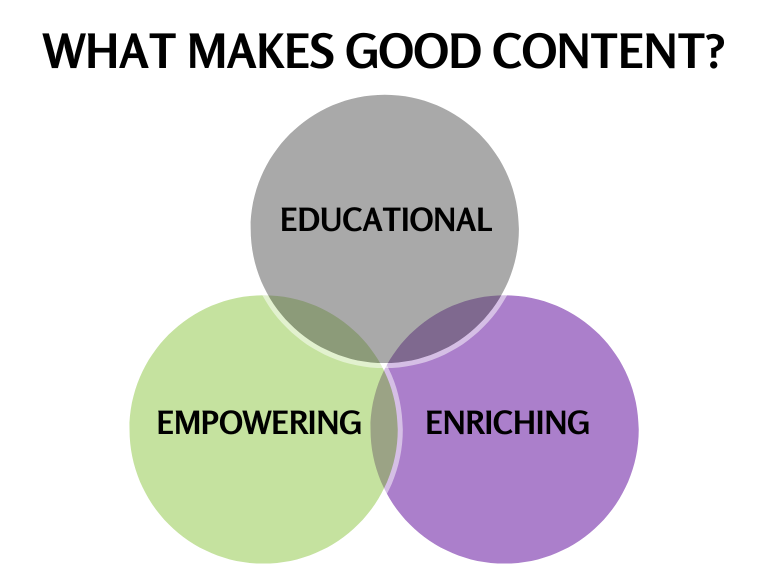
It Starts With Your Audience, and Ends With Your Client
Above all else, your content needs to focus on the client, presented in a way that they can understand, delivered in a way that is compelling and offers actionable insights into the legal world. Your potential clients aren’t looking for you to address them as you would a fellow attorney. They are not looking for you to sell to them. They’re looking for your help.
Giving them that help lies at the heart of the client-centric approach you must adopt if you want your legal marketing to pay dividends. The online experience is one that allows for immense personalization, and as such your potential client needs that personal attention. When you design your legal marketing with them in mind, that’s exactly what you give them, thus forging a greater sense of trust and ultimately creating long-term relationships.
When you build your website, that needs to be top-of-mind. Not creating a place on the internet to list your accomplishments and celebrate your victories, but a portal for potential clients seeking answers, enrichment and affirmation. For many clients, this will be their first impression of who you are as a firm and what you stand for. The content you create, through your website and across the various platforms, holds value not just for your clients, but for your firm.
It bolsters your reputation online, ensuring that search engines can find you. It engenders a sense of trust, one of the most crucial elements between attorney and client. It creates ongoing engagement, and a sense of loyalty that turns clients into advocates. In a digital world, it sets you apart from your competition.
A Simple Process to Getting Started

Schedule a Discovery Call
Schedule a no obligation, discovery consultation on Zoom or in-person.

Receive a Custom Proposal & Strategy
Receive a custom proposal and strategy based on your unique needs.

Start Growing
Start growing your brand online.


